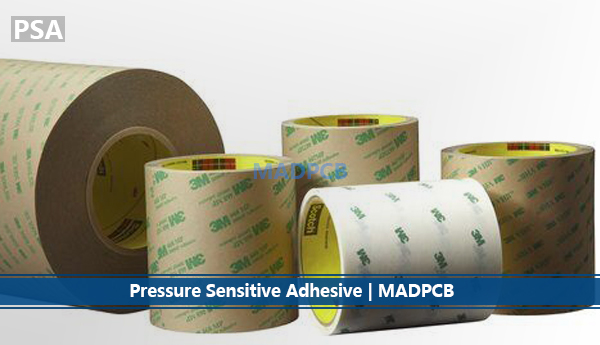Table of Contents
Pressure Sensitive Adhesive (PSA)
Pressure-Sensitive Adhesive is a tape, also known as PSA, Self-Stick Adhesive, which is a major category of adhesive tapes and is a relatively thin flexible material with single-sided or double-sided coating.
PSA ensures that adhesive tape can adhere to a variety of substrates of flex- and flex rigid PCBs, and different FPC stiffeners, like PI, FR4, stainless steel and aluminum, at the slightest of touch when applied to most clean and dry surfaces with pressure.
Commonly Used PSA Tapes
The commonly used pressure sensitive adhesive materials to bond stiffeners and FR4 frames (as supporting plate, similar function as SMT carrier) on the flex circuits are:
- 3M467
- 3M966
- 3M9077
- Tesa 8853
- Tesa 8854
- Other double-sided PSA tape models as required
Benefits of PSA Tapes:
- Thinner and lighter material
- Bonds dissimilar material without incompatibility concerns
- Provides vibration dampening and noise reduction
- Reduces assembly time
- Eliminates the need for surface refinishing
- Provides uniform thickness and gap filling properties
FPC Adhesive (Bonding Sheet) vs. PSA
Stiffeners are added to the flexible circuit as one of the final fabrication steps and can be applied with either a layer of pressure sensitive adhesive or a layer of thermal setting adhesive –Bonding Sheet. From a low-cost perspective, the PSA application will most often be slightly less expensive. Thermal setting on-flow adhesive requires the flex PCB to be placed back in the lamination press to apply the heat and pressure needed to cure the adhesive, which has to be pre-cut to the specific shape of the stiffener itself by laser cut or die punching.
Type of adhesive will also depend upon the configuration and or location of the stiffeners. For an example, if a stiffener does not extend out to the circuit outline it will, in most cases, require a PSA attachment and an additional stiffener outline added to the silkscreen to allow for accurate placement.
- Thermally bonding with heat and pressure is the preferred method to thermally bond the stiffeners to the circuit with the same flexible adhesive as used to attach the coverlay, and this will result in a very strong permanent stiffener bonding.
- Bonding only with pressure is an alternative method to bond stiffeners, which is done with PSA if the design prevents the use of flexible adhesive. The specific PSA will depend on whether the flex PCB will be subjected to an automated reflow cycle and/or what material it is to adhered to.

